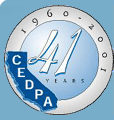

DataBus - Vol 40 No 4: June-July, 2000
|
President's Corner
This issue of the DataBus covers a variety of topics surrounding educational technology -- from life after E-rates and what your district should be considering if these funds diminish, to new bills and appropriations for technology and what you should know about SB20 and AB1942. Highlighted this month is the ever-changing role of CEDPA's members as technology begins to truly integrate into the curriculum. You'll also get a glimpse of how the conference in Santa Barbara is shaping up. Thanks to our conference chairs, things are shaping up quite nicely! The annual CEDPA conference is just a few months away and we are working hard to bring you the latest information and important contacts to make this conference the best yet. Our keynote speakers are Vice Presidents and General Managers of K-12 Education from two of the industry's leading companies, Microsoft and Dell. The break-out sessions have been expanded to include two featured sessions each day. And again this year, the network operations center (NOC) promises to demonstrate all sorts of new technology. We're providing lots of one-on-one time with engineers that can explain how you can make the most of these technologies in your environment. With a full day dedicated to our vendor show, you'll be able to find just the right resource to assist with your technology needs. For more details, be sure to read this issue cover to cover. CEDPA's focus over this school year has been on the virtual learning community. As districts are developing new models, the look of technology in schools across the state is changing. In the Lemon Grove School District, we have had great opportunities to extend learning beyond the classroom. The district has adopted a model that supports a 1:2 ratio of computers to students increasing access in class while making the same resources available through affordable network appliances at home. Currently, we are in our third year of a program that includes technology implementation and professional development for an additional 20 percent of staff each year. However, this year we made a shift in the types of computers we were buying to equip the classrooms. By reallocating existing workstations and purchasing thin-client terminals instead of computers, we were actually able to increase access without extra dollars. It is an exciting experience to walk into a classroom with four multi-media computers and twelve networked appliances and see a dream become reality! But it is not the technology that is the real excitement, it is the change that's occurring in instruction. Our new classroom model finds student desks clustered around the room, two Winterms with each cluster of four students. From 6th grade teacher, Jesse Johnson, "The computers are not an intrusion, they are a natural part of the environment. We pull them out when needed (and that can be either planned or spontaneous moments) and we can shove them aside and get out the construction paper or spread out materials. The computers are a natural part of the desks and classroom and not a bank of computers in the back of the room you go to. The Winterms and the one computer to every two student ratio have totally embedded technology in the teaching and learning process." Each day our network is expanding. As we add more students online from home or provide one more classroom with adequate access to technology, our department's role continues to make significant impact in the district's overall goal of improving student achievement. Just last week, as Bill Gates reported to the US Senate subcommittee on the importance of technology in K-12 education, he described the Lemon Grove School District's success with a connected learning community. I'm still reminded of his ending remarks that "the best is yet to come."
Editors's note: Lemon Grove School District's effort to network the school district and its community was recently acknowledged by Microsoft Chairman and Chief Software Architect Bill Gates at a Congressional hearing in Washington, D.C. He and other top high-tech executives told Congress on June 6, 2000, that improving research and education are the keys for driving new technology in the decades to come. At the hearings, Gates talked about the Lemon Grove School District's Connected Learning Community as a model where the district acts as a hub that connects student, parents and teachers over a community-wide network and provides access to electronic resources and information 24 hours a day. To view an excerpt of Gates' testimony, view C-SPAN coverage of the US Senate Technology & Economy subcommittee hearing at mms://209.242.130.158/mssenate2.asf. Windows Media Player must be installed on your computer in order to view this excerpt. Advance the time indicator to approximately three minutes into the presentation.
|
CEDPA